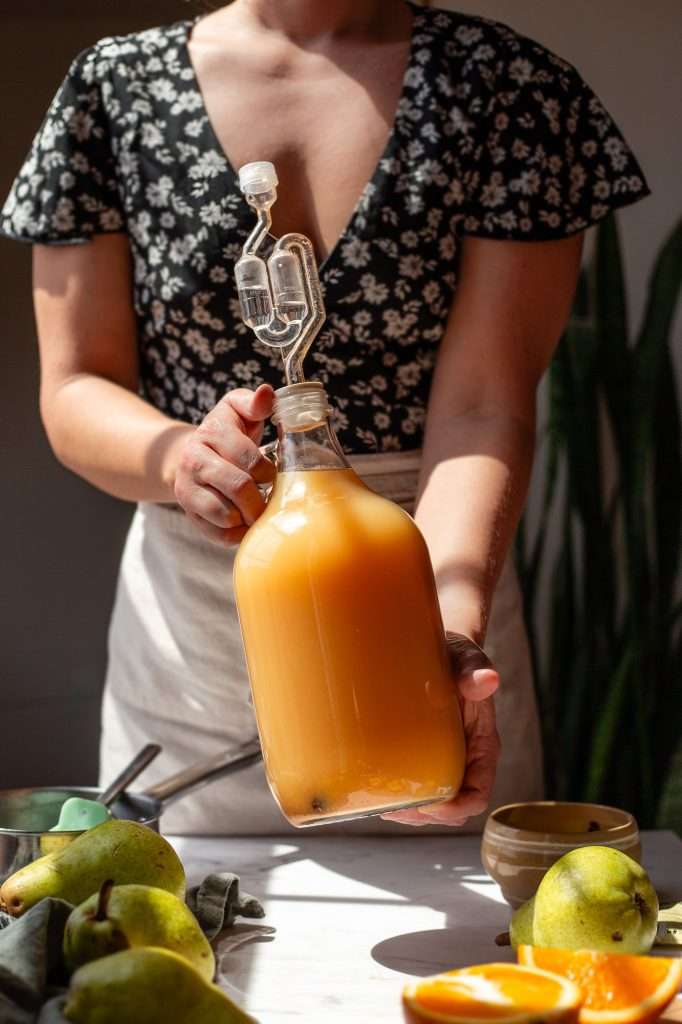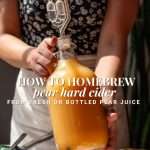- 64 fl oz pear juice, organic
- 75 grams brown sugar, organic
- 1 cinnamon stick
- 5 slices ginger root
- 4 orange slices, organic
- 2 grams cider yeast
- Clean and sanitize all of your equipment. I like to wash the jug* with soap and hot water, allow it to air dry a bit, then rinse the jug with cheap vodka, and allow it to fully air dry. (The vodka just helps all the excess water in the jug evaporate). You can also sanitize equipment with boiling water.
- Once your equipment is prepped, add 16 ounces of the pear juice to a small pot.
- Add the sugar, cinnamon stick, ginger root, and orange slices to the pot with the pear juice.
- Bring the juice and spices to a boil, and reduce to a simmer. Simmer for about 5 minutes, then remove from heat.
- Allow the juice to cool to room temperature (you can speed this up by setting the pot on top a tray of ice).
- Once the juice/spice mixture is cool, use a clean fork to remove the orange slices, cinnamon stick and ginger root pieces and set them aside.
- Use a funnel to pour the spiced juice into your clean jug.
- (optional) add one of the orange slices and a couple ginger slices to the jug.
- Add in the cider yeast and mix gently by swirling.
- Carefully using a funnel, add the rest of the pear juice to the jug, leaving about an inch or two of headspace (see pictures above)
- Cap the jug and swirl it around for about a minute.
- Remove the cap and place the airlock and stopper in the jug (see pictures above, your airlock should be clean with fresh water in it).
- After a few hours, you should notice bubbling in the pear cider and activity in the airlock.
- Allow the pear cider to ferment for 7 to 14 days until the bubbling has completely stopped and you no longer see activity in the airlock. At this point, you should see sediment in the bottom of the jug.
- Remove the airlock and using a funnel, transfer the cider to a new, clean jug for aging. Be careful pouring, pour gently, leaving the sediment in the bottom of the original jug.
- You can use the airlock stopper to seal the jug again or a regular cap. Allow the pear cider to age at a cool room temperature or in the fridge for four weeks.
- After aging, you can rack the cider again and age it for a few more weeks, or move on to bottling. To make this a still cider instead of sparkling cider, do not add any honey or sugar when you bottle it.
- To Bottle the pear cider with honey: Clean and sterilize two 1-liter carbonation-safe bottles. Add one tablespoon of honey to each 1 Liter bottle. Using a funnel, transfer the cider from the aging jug into the carbonation-safe bottles, leaving any sediment in the bottom of the jug. Cap the bottles and invert gently twice to mix the honey with the cider.
- Allow to ferment in the bottles at a cool room temperature for five days, then immediately store in the fridge. (check the carbonation by carefully opening a bottle over the sink, if it is not carbonated enough you can leave it at room temperature for seven days.)
- You can age the bottled cider for 3 more weeks in the fridge before enjoying it chilled. Keep refrigerated.


